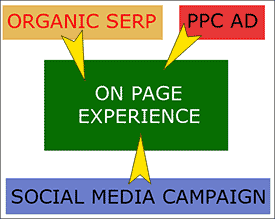User mind models matter when it comes to keyword research. They matter when you write the copy for Meta Descriptions, PPC Ads, on-site content, link names, and link placement. They matter when you’re creating that next viral social media piece, and when you’re establishing that Twitter usage policy. They matter in every aspect of the online experience, so they should matter to you.
 Football or Soccer? Windshield or Windscreen? Lunch bag or sack lunch? Soda or Pop? One word links or five word links? Lots of images on this page or none? Put supporting info in PDF files or actual web pages? Is this site the best to get an inbound link from or is that one, over there?
Football or Soccer? Windshield or Windscreen? Lunch bag or sack lunch? Soda or Pop? One word links or five word links? Lots of images on this page or none? Put supporting info in PDF files or actual web pages? Is this site the best to get an inbound link from or is that one, over there?
Are this site’s users patient Internet age types or are they older people who get frustrated trying to figure out what a “right-click” is? Are they 3rd year graduate students or rocket scientists? Do they spend all their time outdoors or are they couch potatoes?
Are this company’s ideal customers Twitter twits or Facebook fanatics? Are they conservative or liberal?
Beyond The Technical
No matter how skilled you might be at implementing a technically stellar SEO, PPC or Social Media strategy, if you don’t first put in the footwork to understand the unique way a site’s users think, or how they digest their information online, you’re going to fall short. Because of this reality, I always put in just as much time into understanding the user’s mind model as I do any other single aspect of the marketing process.
A whole book could be written on this one topic, so I’ll just cover the bases here, imploring you to take away from this article the concept that understanding the mind model of your users is a critical responsibility…
Marketing – Its A Team Sport
Okay so you’re the one who wears all the hats. Your team consists of your ego, your inner child, your codependent parent, your favorite high school teacher – you know – all the voices in your head… In that case, good luck. You’ll need it.
For the rest of us, we rely on and are typically required to, collaborate with others. Site owners. Graphic Designers. Engineers. Sales people, ad agency creative types. Marketing people….
If you’re like me and you do participate on an IRL (not inner mind) team, the more YOU understand the reasons it’s critical to understand the REAL user’s mind model, the more you’ll also want everyone else to understand why it’s so important to figure that out as well. And the more everyone on the team grasps this fundamental truth, the more effortless YOUR job will be as the search and/or social media marketer.
So one of the best suggestions I can make to you is take responsibility to learn about site users for the next site you’re working on. And include that information when you’re trying to get the designer to change that butt-ugly neon-glow “buy now” button, or for the video script writer to reconsider including that half naked woman, even though you’re just the online marketing hack…
Expand Your Mind
Don’t just rely on keyword research tools, or the site owner’s understanding of keywords. Don’t just think you’re the average user of the site. Don’t assume just because YOU think that video is perfect, and funny, that people with purchasing power capabilities do. Don’t assume the graphic designer’s artistic flair is going to cut it. Or the engineer’s neat new widget is really going to be of value…
Take the time to step into the customer/end client’s shoes. “If I were looking for this product, these services, how would I search for it?” How would I feel when I see THIS page, or have to use THIS widget? How would I react to that visual in the video? Or that persona on Twitter?
Before you try and think like that person, the best action you can take is to clear your mind of your own personal way of thinking about the product(s) or service(s) you’re going to need to get found or remembered for the right reasons. Because it’s all too easy to cloud our vision with our own previous thinking.
Routinely Step Outside Your Vision
Actually take the time to envision who the ideal target person is. What’s their life like? Are they wealthy, middle class or poor? What is their cultural background? What’s their education level?
What kind of things might they read in their spare time? Yes – that’s right – I actually think about that. And it’s why I have subscriptions to
- Popular Mechanics
- Readers Digest
- National Geographic Traveller
- Popular Science
- Entrepreneur Magazine
- Newsweek
And it’s why I don’t hesitate to read
- Cosmopolitan
- USA Today
- Wall Street Journal
- People
- Time
- Lady’s Home Journal
- Scientific American
I don’t stop there though. If I’ve got a client with a site that targets a market in a different realm, or a social media channel inside a niche market web presence, I’ll seek out and read a lot of material that’s geared toward that unique market. Whether it’s in the health, nutrition, financial, education, Gen-Y, retailing, manufacturing, retiree or whatever field it happens to be in.
Don’t Trust Existing Sources
When it comes to discovering keywords, a lot of people in our industry suggest (rightly so) to look at a site’s analytics to see which long tail and alternate phrases you might have an opportunity to put more emphasis on. Alternately they’ll tell you to look to see what the competition is doing (also rightly so). This is just as dangerous when evaluating a “voice” – whether it’s for site content, a social media campaign, or a company Twitter account.
Yet I can’t emphasize enough how important it is to realize that you need to consider these sources with extreme caution.
First, if you’re looking at analytics data on the site you’re working on, that’s going to be heavily skewed based on the quality of the previous optimization process. There could be dozens, hundreds, or thousands of keyword phrases not showing up there that by all rights are as good as, or even better than what you see.
Second, just because your competition is using certain phrases doesn’t mean they put in the right kind of footwork either. Imagine a world where all the sites are optimized for the wrong phrases? Oh sure – everyone’s probably getting traffic. But what if it’s only a small fraction of the real market?
And just because the Old Spice guy was a hit, do you really think that concept would work for an ad campaign for abortion rights or Catholic Charities?
Question Everything
If you’re doing SEO or PPC or even Social Media marketing, to get maximum results you absolutely need to at the very least, participate in the decision process. Whether it’s PPC specific landing pages, or content writing, or link labels, or anything that can impact the success of the rest of the SEO, PPC and Social Media effort, understanding the user mind model while they’re on the site itself or following that Twitter account, or connected to that Facebook fan page, is as crucial as it is when choosing keywords, writing PPC ad copy, or which social media channels need attention.
And when it comes to the user mind model, assume nothing.
Test Test Test
Assume that the only way to optimize a user’s experience on a site is to do A/B split testing with the entire look and feel of the site, with the length of content most pages have before splitting out additional content to new pages, whether those text links you’re embedding directly in the content are annoying to users, or helpful, whether having “customer service” be a tiny link in the footer is enough or having it be a primary navigation link actually communicates trustworthiness…
And if that’s the case, that page or section is yet one more opportunity to optimize a top level page that can be used to support other sections or pages…
Remember- just because YOU are used to “FAQ” pages, doesn’t mean granny is. Or that nun who only spends an hour a year online does…
For Social Media, do A/B tests with small groups or a limited set of users. Don’t just hope you’ve got it right and go full tilt on your first try.
 Everything Relevant To On-Site
Everything Relevant To On-Site
The more the SERP relates to the page, the more likely the user won’t abandon the site right away.
The more the landing page relates to the PPC ad, the more likely they’ll consider converting.
The more a landing page relates and seamlessly transitions a user after they come to the site from a social media link, the more you’ll keep them, and ultimately convert them.
The more the page relates to it’s keyword topic, the higher it will rank for short and long tail. The more closely a group of pages relates to each other within a funneled section, the stronger all of those pages are, and in turn, the stronger that entire section is from an SEO perspective.
The more the user experience becomes intuitive for THAT user mind model, the faster they’ll find what they’re looking for. The faster they find what they’re looking for, the more likely they’ll be motivated to convert to a member, lead or sale.
The more enticing the user experience (again – for THAT user mind model), the more all of these will be even further increased.
I can go on and on – but hopefully you’ve gotten the message by now.
The Bottom Line
As much as it would be dandy if everyone on the team cared as much about the user mind model as I do, sometimes I’m the only one who cares. Or understands why it’s so important to care. And just like me, you too may be the only one on the team who gets it. Don’t ignore the opportunity. Jump on it. When you do, everyone may initially balk, yet they’ll all eventually come around. Hopefully.
__________________________________
photo courtesy Marco Bellucci




